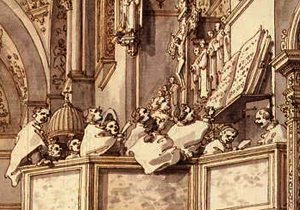Sacred Music in Liturgical Context

Musicians at San Marco in Venice
In the early 80s, while studying baroque cello at the Schola Cantorum in Basel, Switzerland I had the opportunity to play Bach St. John Passion at a lovely church in the Schwarzwald. I was thrilled. There are few assignments for a baroque cellist that can compare with being in the middle of this consummate masterpiece and I set about studying the work in preparation for the project. My German was even worse then than it is now, and I struggled to to stay afloat in the rehearsals with the help of an expat colleague who sat near me in the orchestra. I eagerly looked forward to the performance but I was a bit perplexed at first by by the fact that it was scheduled for 3:00 pm on a Friday afternoon.
It didn’t take me long to figure out that, of course, Bach’s work was to be performed as part of the Good Friday liturgy. More than just the unusual timing made sense to me that afternoon.
Anyone who has played or attended a concert performance of the St. John Passion is struck by the imbalance of the two sections of the work – so counter to the accepted wisdom of good programming. The first half is always longer than the second and the intermission arrives uncomfortably early in the program. This, of course, is not an issue in the liturgy for which the piece was intended.
Once the liturgy made its way through Introit, Kyrie, Gloria, prayer, and epistle, I remember a certain satisfaction in hearing the congregation singing a chorale that would later appear within Bach’s Passion setting. The balance and integration of the full experience left me convinced that Bach, the great master, knew what he was doing – he wrote his Passion with a specific liturgical context in mind and never even considered the possibility that it might be performed in a concert hall, divorced from that liturgy.
I considered other great musical works that set liturgical texts and became intrigued by the notion of performing them in their original liturgical context, albiet in a concert, rather than a actual liturgy. I first had a chance to try this out in Magnificat’s first season in performances of Schütz’ Weinachtshistorie, and found that the experience of reconstructing the liturgy for a mid-century Dresden Christmas Vespers was immensely challenging and rewarding. The overwhelmingly positive response of the audiences at those concerts convinced me that this was an approach worth pursuing that fit perfectly with Magnficat’s emphasis on the historical and social context of the music we were exploring and performing.
In the years since that first experiment, I have had many opportunities to offer audiences the chance to hear great works of sacred music surrounded by chanted texts, chorales, and service music that would have adorned the music originally. Each project has presented a different musical-historical puzzle through which I have learned a great deal about the aesthetics and culture of the music I programmed – knowledge that has enriched the experience for performers and audiences alike.
Magnificat’s liturgical reconstructions will never be like my experience in the Schwarwald church two decades ago – there is no pretense that these programs are anything but concerts. However, they have given the musicians and audiences a very special sonic taste of those who first participated in and listened to so many of the great works of scared music.